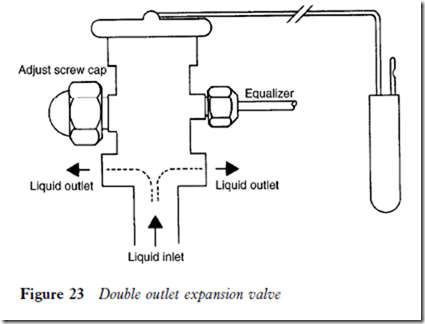Replacing a thermostatic expansion valve
There are a number of reasons for replacing an expansion valve:
1 Mechanical failure of the valve: possible seizure of the valve stem carriage; worn valve seat and letting by; defective or wrong sized valve orifice cartridge.
2 Partial loss of the thermal charge: insufficient pressure exerted by the power head in response to temperature changes, resulting in an erratic valve operation.
3 Complete loss of the thermal charge from the power head: the spring pres- sure will close the valve and refrigerant flow to the evaporator will cease.
4 An excessive pressure drop across the evaporator is discovered: an external equalizing type has to be substituted.
Complete loss of thermal charge
When this condition exists there is effectively a total blockage in the high side of the system (liquid line). The pressure in the low side of the system may be negative, or that determined by the cut-out setting of the low pressure control.
The system is therefore ‘pumped down’ from the point of the blockage, in this case the expansion valve, and there is no need for the pumping down procedure to be carried out. There is, however, a liquid line full of liquid; unless an isolating valve has been installed, this liquid must be removed.
If there is a liquid charging valve at the receiver with an appropriate connector, it may be possible to transfer the liquid into an empty refrig- erant cylinder. If not, it must be reclaimed. The following procedure should be adopted:
1 Isolate the plant electrically and close the liquid shut-off valve at the receiver.
2 Front seat the suction service valve.
3 Release the thermal bulb from the clamp at the outlet of the evaporator.
4 Ensure that the working area is well ventilated. If any food products are in the immediate vicinity they should be removed or covered as a protection against contamination.
5 Check the orifice size of the new valve, and check that it is suitable for use with the system refrigerant.
6 Remove the defective valve and install the replacement. Remove the old bulb clamp and fit the thermal bulb of the replacement valve to the evaporator outlet in the original location, using the new clamp provided with the new valve.
7 Open the liquid shut-off valve at the receiver.
8 Leak test the connections which have been disturbed.
9 Set the suction service valve to the operating position and start the plant.
10 Operate the plant until pressures have stabilized. Check the refrigerant charge via the sight glass and operating pressures.
11 Adjust the valve to give the recommended degree of superheating.
12 Remove gauges, cap service valves and carry out a final leak test.
13 Clear the site of debris, oil etc.
The system may be evacuated through the gauge port on the compressor. Crack off the suction service valve from the front seat position and allow a small amount of vapour to enter the compressor crankcase. Front seat the suction service valve again, slacken off the gauge port union and evacuate the compressor. After evacuating, set the suction service valve to the operating position and continue the above procedure at step 12.

